If you’re a regular TIA reader, it’s not breaking news that Mac recently revamped their cordless line with a pretty impressive lineup powered by Dewalt’s proven 20V Max platform. You may have even read my recent review of the 12V Ractchet from said lineup. If you’ve come here from Google you might also be aware that TIA is currently the only tool blog on which you’ll find reviews of Mac’s new cordless lineup. That’s important right? I mean, almost 6,000 people have summited Mt. Everest, but Sir Edmund Hillary is probably the only one you can name.
Features & Design
As you would expect, the BWP050 was designed with professional users in mind. It’s a full size gun, but with a light weight and handle forward design, it doesn’t strike you as bulky and is remarkably well balanced for a big gun. The “glass filled nylon” body feels distinctly different than it’s Dewalt cousin and is designed to better resist automotive fluids. The rubber grip is comfortable and bumpers adequate for their purpose. The variable speed trigger and electronic brake make the operation smooth, even in more finesse applications. I like that the bell housing is finished in satin rather than full polish as it will stay looking better, longer. The selector switch is positioned nicely. It allows for easy, one handed, directional changes, but doesn’t get in the way like some do, especially with gloved hands. The LED light stays on for :20 after the tool is disengaged and is merely adequate. It’s located under the bell housing which does cast a shadow, but I suppose it’s better protected there. Unlike the 12V line, the 20V line does feature the on battery status gauge. It also includes a multi-volt charger (20V/12V), a kit bag, and the same 1 year free service deal that the other Mac cordless tools offer.
Performance
High torque impacts are very hard to test in an end user setting. Even in professional auto shops and industrial environments it’s difficult to replicate the insane levels of torque these guns are capable of. There are certain fasteners like rusty trailer hitch balls and Honda crank bolts that have a reputation for being stubborn, but even then the results are less than conclusive. To provide a unique test, I removed my trailer hitch ball using the BWP050. I applied High Strength Red Loctite (271), and reapplied the nut with all the force of my Proto J150WP which we know currently shares the title of “strongest 1/2″ air impact on the market” with the Mac AWP050. I let the Loctite cure for about 6 hours, and put the BWP050 in charge of taking it back off. My point was to try and simulate a few years of rust and crud in the threads.
Check out the results for yourself:
As you see the BWP050 came through without much hesitation in what was in reality, a pretty tough test. For shiggles, after re-applying the nut with the BWP050, I put the J150WP back on it to see what happened. I got about 1/2 a turn or so. I reapplied the nut and Loctite in the same fashion, and repeated the test with a 12 hour cure time. It wouldn’t bust it that time, but I really didn’t expect it to. I performed the same test on the W7150 awhile back and had pretty much exact results. Our kit came with 2 XR 3.0 batteries. With intermittent use we had all day run time out of one pack. The charge time is 1 hour, so it’s highly unlikely you’ll ever have to worry about out pacing your batteries.
The Dewalt Connection
On more than one occasion when discussing Mac’s new cordless line I’ve heard/read someone suggest they were merely rebadged Dewalt tools. In a side by side comparison it quickly becomes evident that isn’t the case. The chart below shows how the BWP050 specs out against Dewalt’s high torque gun, the DCF889:
Looking at the physical characteristics it becomes even more evident they aren’t the same tool. Aside from the battery, there really isn’t anything alike between the two:
Mac vs. The Competition
With competitors like IR and Milwaukee publishing eye opening numbers regarding “Nut Busting Torque”, it’s perplexing that similar to Dewalt with their UWO (Unit Watts Out) ratings, Mac doesn’t claim a “Nut Busting Torque” rating. I’ve got hands on time with all 3 and quite honestly, it’s a dead heat as far as power is concerned. The Mac has the best balance in my opinion, but there are things I like about all 3. The chart below compares the specs of the 3. I’m not certain exactly what the weight is on the Milwaukee without the battery, but it is the heaviest of the 3.
Looking at the chart we see some very competitive numbers. Though the Milwaukee is the only brushless model, the Mac bests the Milwaukee in every statistical category with the exception of the 1/2″ difference in length. When compared to the IR, Mac comes out ahead in 3 categories, though they are almost identical in length and weight. We’re really splitting hairs here though aren’t we? In the grand scheme of things the differences between the 3 are pretty negligible.
Still, the lack of a “nut busting torque” rating keeps my wheels turning. We see from the known stats and our tests that the BWP050 is a perfectly capable gun with seemingly nothing to hide, but I couldn’t stop wondering why they don’t quote a “nut busting torque” rating. So I called and asked them.
We know that there is no industry standard as to how torque ratings are calculated for power tools, but it turns out that developing some of these ratings is kinda like a choose your own ending novel. There are so many variables like bolt type and size, thread factors, air pressure, CFM, etc., that ratings can be easily manipulated. Back in November, CopTool did a side be side comparison of the 7150 and 2763. Even using a Skidmore machine they were reluctant to confirm or deny the manufacturers torque claims. As with Dewalt, Mac has taken the high road by simply not publishing an unstandardized rating to grab your attention. Am I saying other manufacturers are being dishonest in publishing one? Certainly not, but it does make me want a standardized method of measurement before we go handing out accolades to one gun or another.
Mac vs. Snap-On
I’ve said it before, and I’ll say it again, Mac has the nicest cordless line on the trucks. The chart below compares the BWP050 to Snap-On’s new high torque CT7850M (rumored to be Bosch built).
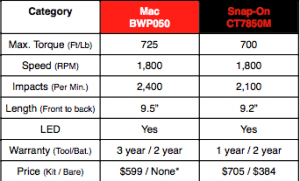
* Mac does not offer a bare tool option, however, there is a 1 battery kit, the BWP050-LN1 that does not include the bag or charger for $499
Though the stats are fairly close, when you factor in the additional 2 years of warranty, the $100 kit savings, and the Dewalt compatibility, the BWP050 is an attractive option.
Conclusions
Overall the BWP050 is a nice gun. The combination of Dewalt technology and Mac’s automotive know how delivers plenty of power, in a well balanced, user friendly, package. If you’re in a shop along a Mac route, or just heavily invested into Dewalt’s 20V Max line, the BWP050 is certainly worth your consideration. The level of torque we’re seeing from cordless guns these days is pretty amazing when you think about it. Sure, there are stronger air guns out there like the J150WP or AWP050, but for the vast majority of users the Mac, IR, Milwaukee, or Snap-On, offer true air gun replacement. The real winner in this torque rating renaissance is the end user. We’ve seen some great tools over the last couple of years and I can assure you it’s only going to get better. As far as critiques, we’d of course like to see a 5 year warranty, and the LED could be better, but overall we’re completely satisfied.
As always, stay tuned to TIA for more from Mac Tools!

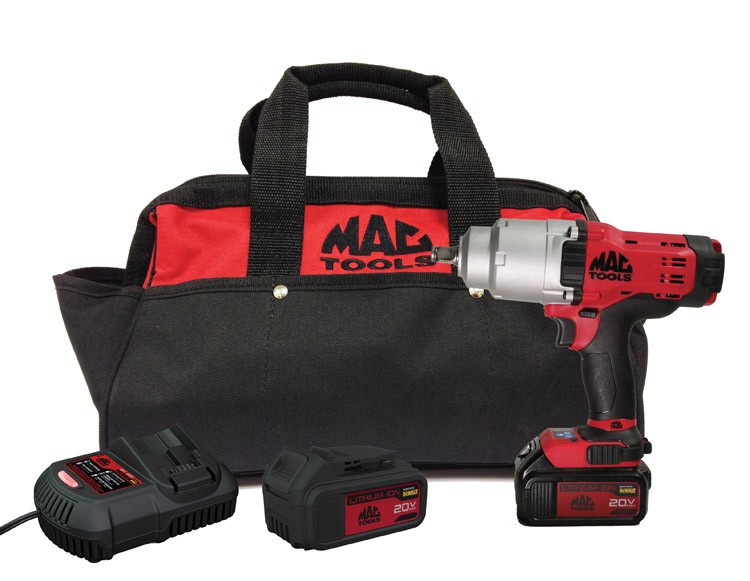

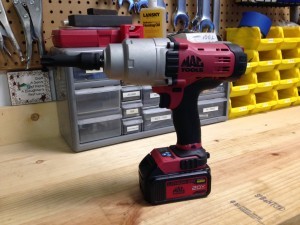
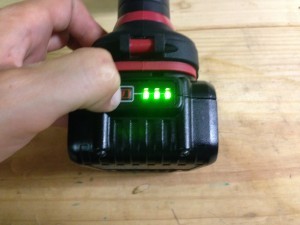

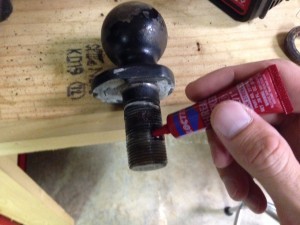
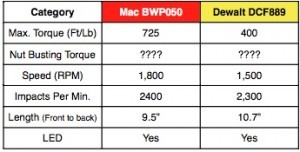
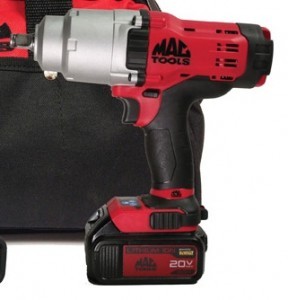

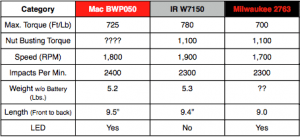
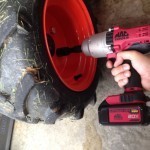

Thanks for the excellent review Travis! I am very surprised to see that Mac has been able to get anywhere near the power of the 2763 or W7150. I do think you are correct when you say that there is no “industry standard” when it comes to torque testing, however I have confirmed with Milwaukee & Ingersoll Rand that they both use calibrated Skidmore-Wilhelm machines to verify torque ratings.
In my testing of both the 2763 & W7150, I believe that the power levels are so close they cannot be differentiated without scientific testing. In the real-world applications that I have put them up against, neither has failed at anything…….including the next-to-impossible Honda Crank Bolts. In the 2 reviews that I did, I showed each removing 2 Honda Crank Bolts with ease…..something that 95% of pneumatic impacts cannot do.
Looking at the numbers you listed for the Mac, it seems that this could be the 3rd impact out there that could achieve that….which is very encouraging, since it will only increase competition and innovation within the tool manufacturing community.
As far as the term “nut busting torque”, I thought this was some marketing scheme when I first heard it…..however, I have confirmed with both Milwaukee & Ingersoll Rand that in their testing of these units, they torque bolts to 1,100 ft-lbs with a calibrated torque wrench & the impacts WERE ABLE to remove those fasteners….so that is where they are coming up with that term.
Also, as far as the “forward torque” goes, I think that is extremely hard to measure in real-life, simply because no normal applications require anything near 700 ft-lbs. In the COPTOOL video, the 2763 & W7150 both hit 900 ft-lbs forward torque…..when I asked Milwaukee why this occurred, they told me flat-out that “the larger the fastener, more torque will be applied until it basically fuses the threads”. I unfortunately confirmed this unintentionally, because when I was testing the 2763 I wanted to see “how tight” I could make the nut on the trailer ball (1″ shank w/ 1 1/2″ nut)…..I hammered on it for 7-8 seconds & the threads literally fused together and ripped off of the shank & stripped out of the nut. So there really IS “too much power” when it comes to power tools. I hope instead of the companies focusing on more power, they switch over to focusing on longer run-times.
Great job Travis!
Great review Travis, im not convinced it has the power of the other two, but still is a nice gun
The Milwaukee is the heaviest at 6.2 lbs.
I think the advantage still goes to the Milwaukee here though. For any brushed tool, performance will diminish as the brushes wear. For a tool like a drill or a sawzall, that’s fine, don’t force the tool as much so while it takes a little longer, it still works a few years down the road. For an impact wrench though, the work you can accomplish with the tool will diminish. When that fastener won’t budge, no amount of extra time on the trigger will break it loose, and you’ll have to break out the breaker bar and some other tool to counteract the force (I’m thinking specifically crank pulley bolts, flywheel bolts, etc here).
I hope more mfgs bring out some brushless impact tools to challenge the Milwaukees, them just sitting on top doesn’t really give them incentive to put more R&D into the tool.
Wow!!… great review, you covered pretty much everything. Very hard to find a hands on/ comparisons/reviews in the internet for this tool. There is a bare tool option though, it’ll run you around $440.00 but my mac guy hooked me up. I haven’t even used it yet but I am very excited too. Every one at work is crazy about the new snap on ct7850m, I was wondering if you guys could do a review on it or a vs with the bwp050. Would love to know what you think is better between the two.
Thanks OB! You made a wise choice. The new Snap-On cordless line is rumored (though I feel it’s pretty much confirmed) to be built by Bosch. I got to play with one on the truck, but didn’t get a chance to actually do any work with it. The CT7850M is nice, and while it specs out really close to the BWP050, I still feel that with the price and warranty difference, and the Dewalt compatibility, the 050 is the better option.
When I called Mac about the bare tool option, the product manager told me “there wasn’t one and you’ll not find any official part number listed for it”. I’d say the driver is simply parting out a kit, but that’s cool he does that and it’s certainly within his right to do.
I have a review coming up on the 3/8″ BWP038. Should have it up in a week or so.
I just bought the BWP050 a couple of weeks ago. So far it has hardly broken a sweat. Had to repower a skid steer last week (excuse I used for buying it). The skid plate bolts were 3/8″ with 30+ years of corosion on them. This impact was snapping anything that didn’t budge instantly. It seems to have about the same power as my Eathquake 1/2″ but much more trigger control. I have some Snap On impacts and a mechanic in my shop uses the Snap On equivelant of my impact. From what I have been able to see they are pretty close. Thanks for posting a review on this tool, not many reviews on these out there.
Necropost here, but since the article, there has been a lot of progress in the full size impact 1/2″ anvil wrench segment:
Makita XWT08:
Brushless, 740 ft-lbs max tightening torque, weight of 8.1 lbs w/battery
Dewalt DCF899
Brushless, 700 ft-lbs max tightening torque, weight of 7 lbs wo/ battery
Makita put the light in the wrong spot. New mac brushless. .. sister to dewalt is now out. Mac now have r spec batteries. Resistance to chemicals. Milwaukee light In wrong spot… and protective boot cost way too much like most of there stuff.
Where can I get the housing for my Mac 050 I broke it where the battery connects to the gun?
Wow, great question. I don’t know. Hopefully someone will come on an chime in.
Have there been any complaints about the noise level of this gun. I have one and every one complains that the noise output is very high when tightening wheel nuts with a torque stick.
Good question. I haven’t heard anything.